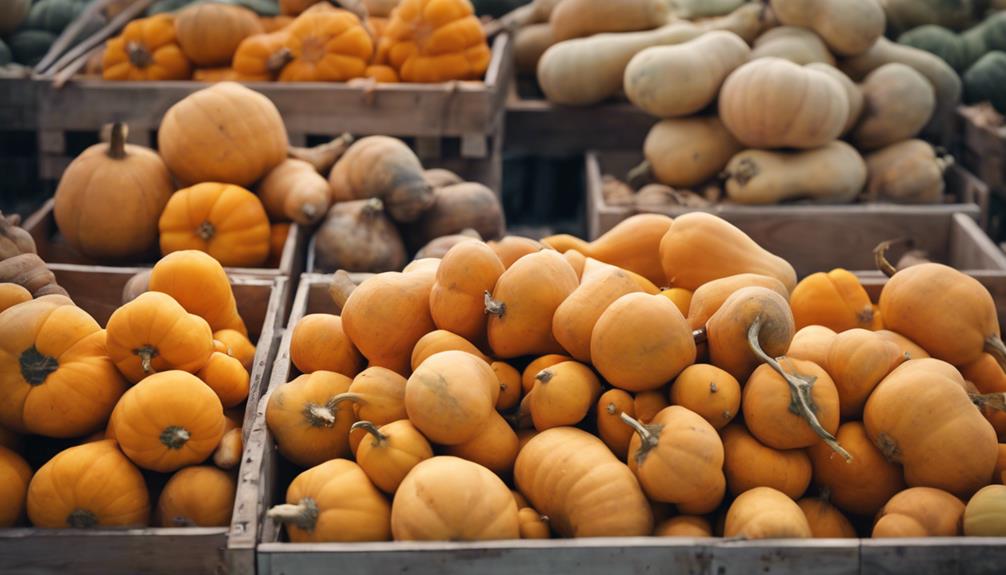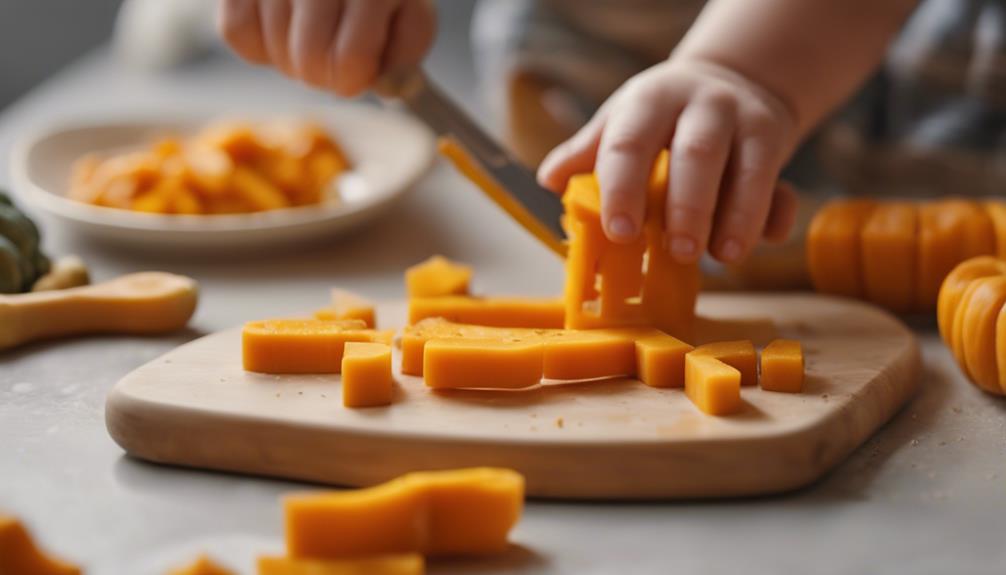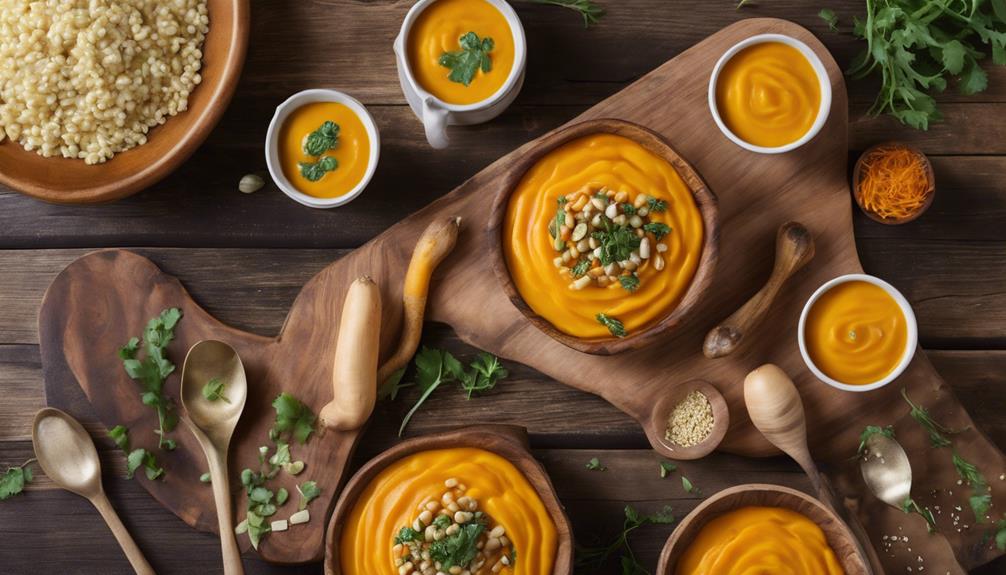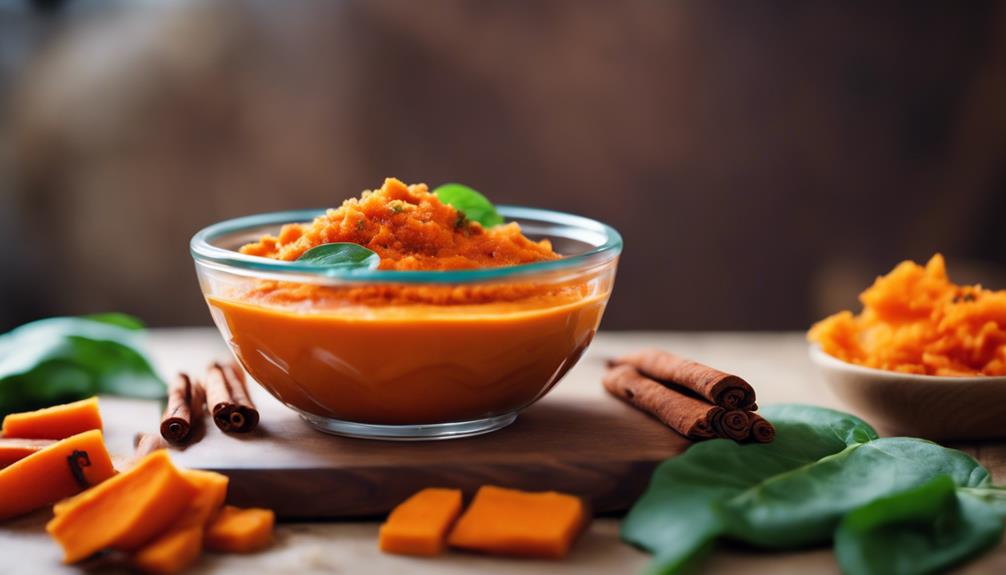For nutritious baby butternut squash recipes, consider making creamy butternut soup for a smooth introduction to this healthy vegetable, or try butternut squash risotto for a naturally sweet and customizable dish. Roasting butternut squash brings out a caramelized flavor that is packed with vitamins. Look for firm, dark beige squash with intact stems to ensure freshness. Roasting can enhance the sweetness, while steaming allows for maximum nutrient retention. Start with small portions and consult with a pediatrician if there are any concerns about allergies. These recipes provide a tasty way to introduce butternut squash to your little one, supporting their growth and development.
Key Takeaways
- Creamy Butternut Soup: smooth texture, rich in vitamins, homemade control.
- Butternut Squash Risotto: customizable, nutrient-packed, supports growth.
- Roasted Butternut Squash: caramelized, rich in vitamins A and C.
- Steaming preferred: retains nutrients more than boiling.
- Mashing or pureeing: baby-friendly textures, easy to digest.
When to Introduce Butternut Squash
When considering when to introduce butternut squash to your baby, aim for around 6 months of age, ensuring they display signs of readiness for solids. Look for cues like sitting up independently and showing interest in food before starting.
It's important to prioritize your baby's individual readiness over a strict timeline. If you're uncertain about starting solids, don't hesitate to seek guidance from pediatricians or dietitians.
When introducing new foods like butternut squash, it's vital to do so slowly and monitor for any adverse reactions. Keep an eye out for signs of allergies or sensitivities such as rashes, vomiting, or diarrhea.
Nutritional Benefits for Babies

Rich in essential vitamins like A and C, butternut squash provides valuable nutritional benefits for babies, aiding in their growth and development.
This versatile food can be easily turned into a smooth puree, making it a perfect choice for introducing solids to your little one.
The vitamins present in butternut squash play an important role in boosting your baby's immunity and promoting healthy growth. Additionally, the antioxidants and carotenoids found in this vegetable support eye health and contribute to overall development.
Butternut squash also offers a good dose of fiber, including both soluble and insoluble types, which can help in maintaining healthy digestion for your baby.
Safety of Butternut Squash

Butternut squash is a safe and nutritious option for introducing solids to your baby, being low in allergenic potential and easy to digest.
When preparing butternut squash for your little one, make sure it's cooked to a soft consistency to prevent any choking hazards. Starting with small amounts can help you monitor for any adverse reactions.
This vibrant squash is packed with essential vitamins and minerals, making it a beneficial addition to your baby's diet. However, if your baby has any known allergies or sensitivities, it's best to consult with a pediatrician before incorporating butternut squash into their meals.
Selecting the Best Squash

For ideal freshness and flavor in your butternut squash recipes, opt for a firm, dark beige squash without green streaks or soft spots. When selecting the best squash, make sure the stems are intact, indicating freshness. Avoid squash with mold, bruises, or cuts as they can impact taste and texture. Smaller or medium-sized squash are easier to handle and cook. Choosing organic butternut squash can reduce exposure to pesticides. To help you make an informed decision, refer to the table below:
| Aspect | Description | Importance |
|---|---|---|
| Firmness | Choose a squash that feels firm when gently pressed. | Ensures freshness |
| Color | Look for a dark beige color without green streaks. | Indicates the best ripeness |
| Size | Select smaller or medium-sized squash for easier handling. | Easier to work with |
| Stem Condition | Make sure the stem is intact, a sign of freshness. | Indicates quality |
When you bring your butternut squash home, store it in a cool, dark place. If you want to extend its shelf life, consider freezing it after cooking or pureeing it in a food processor for future use in baby led weaning recipes.
Cooking Techniques

To bring out the best flavors in your butternut squash dishes, consider experimenting with various cooking techniques. Roasting butternut squash enhances its natural sweetness and depth of flavor, making it a delicious option for homemade baby food. The process of roasting involves baking the squash in the oven until it caramelizes, creating a rich taste that babies often enjoy.
Steaming is another excellent method for cooking butternut squash, as it helps retain more nutrients compared to boiling. Steamed butternut squash can be easily mashed or pureed into a smooth texture ideal for feeding your little one.
On the other hand, boiling butternut squash may cause some loss of nutrients due to water-soluble vitamins leaching out into the cooking water.
Baby-Led Weaning Cutting Guide

Consider incorporating the Baby-Led Weaning Cutting Guide for age-appropriate suggestions on introducing solids to your little one, starting at around 6 months. Here are some key points to keep in mind:
- Developmental Readiness Cues:
Look for signs that your baby is ready to start on solid foods, such as sitting up unassisted and showing interest in what you're eating.
- Safety Tips:
Make sure that butternut squash pieces are cut into manageable sizes to prevent choking hazards.
Monitor your baby closely during mealtime.
- Cooking Methods and Seasoning Suggestions:
Steam or roast butternut squash until it's soft and easy to mash.
Avoid adding salt, sugar, or excessive seasoning to keep it baby-friendly.
- Feeding Tips:
Start with small portions of butternut squash and gradually increase the amount as your baby gets used to the taste and texture.
Pay attention to any allergic reactions or digestive issues.
Storage Tips for Butternut Squash

When storing butternut squash, remember to keep cut pieces in the fridge in an airtight container for up to 5 days.
Cooked squash can stay fresh in the fridge for 3-4 days, while freezing puree in ice cube trays allows for easy portioning.
For longer storage, freeze in proper containers or bags for up to 4 months, ensuring to thaw in the fridge and check for spoilage before serving to your little one.
Proper Storage Conditions
Store your whole butternut squash in a cool, dark place with good ventilation to prevent moisture build-up. Here are some tips to guarantee your butternut squash stays fresh:
- Choose the Right Spot: Find a cool, dark area with good airflow, like a pantry or cellar, to store your whole butternut squash.
- Avoid the Fridge: Keep the squash out of the refrigerator as cold temperatures can spoil its flavor and texture.
- Wrap Cut Portions: Once you've cut the squash, tightly wrap the unused portion in plastic wrap and store it in the refrigerator for up to 5 days.
- Freeze for Longevity: For longer storage, freeze cooked butternut squash in freezer-safe bags or containers for up to 3 months. Remember to thaw frozen squash in the refrigerator overnight before using.
Length of Storage Period
To guarantee high-quality freshness and quality, it's important to follow specific storage guidelines for butternut squash.
When storing butternut squash puree, make sure it's kept in airtight containers to maintain its freshness.
In the refrigerator, butternut squash puree can be stored for up to 4 days, while frozen puree can last for up to 4 months in the freezer.
Before feeding your baby, remember to thaw frozen butternut squash puree in the refrigerator.
It's important to check for spoilage signs like off smells or discoloration before serving stored butternut squash baby food to ensure your baby's safety.
Delicious Butternut Squash Recipes

You can whip up some mouthwatering dishes with butternut squash like Roasted Butternut Squash, Creamy Butternut Soup, and Butternut Squash Risotto.
These recipes showcase the versatile nature of this nutritious ingredient and can be enjoyed by both adults and babies.
Get ready to savor the delicious flavors and textures that butternut squash brings to your table!
Roasted Butternut Squash
Enhance your culinary repertoire with the simple yet flavorful delight of roasted butternut squash. This cooking method not only brings out the natural sweetness of butternut squash but also creates a delightful caramelized exterior that adds depth to its taste.
To prepare this nutritious dish for your little one, follow these steps:
- Preheat your oven to 400°F.
- Peel and cube the butternut squash, removing the seeds.
- Toss the cubes with olive oil, salt, pepper, and your choice of herbs like thyme or rosemary.
- Spread the seasoned squash on a baking sheet and roast for 25-30 minutes until tender and golden brown.
Roasted butternut squash isn't only delicious but also packed with vitamins A and C, essential for your baby's bone health. After roasting, make sure to let it cool before serving to your little one.
This versatile dish can be served as a standalone side or used in various recipes to introduce your baby to new flavors and textures.
Creamy Butternut Soup
Creamy Butternut Soup offers a nutritious and delightful way to introduce butternut squash to your little one. This homemade soup is packed with vitamins and minerals essential for your baby's growth and development. The smooth texture of the soup makes it easy for babies to enjoy, providing a comforting and warming meal option.
By making your own Creamy Butternut Soup, you have control over the ingredients, ensuring that no added sugars or preservatives are included. This healthy choice allows your baby to benefit from the natural goodness of butternut squash without any unnecessary additives.
The delicious flavors of the butternut squash shine through in this creamy soup, making it a favorite among babies. The nutrients present in the soup support your baby's overall health and well-being, making it a great addition to their diet. Try serving this nutritious and tasty soup to your little one today!
Butternut Squash Risotto
Introduce your little one to a delightful and nutritious meal with Butternut Squash Risotto, a creamy and flavorful dish that combines the sweetness of squash with the richness of risotto.
Here are some reasons why this homemade baby food is a great choice:
- The butternut squash adds a natural sweetness that babies enjoy, making it a tasty introduction to new flavors.
- The creamy texture of the risotto is easy for babies to eat, providing a soft and comforting meal experience.
- Butternut squash is packed with essential vitamins, minerals, and fiber, perfect for supporting your baby's growth and development.
- This recipe is highly customizable, allowing you to experiment with different ingredients like herbs, cheese, or protein to tailor it to your baby's preferences and nutritional needs.
Prepare this nutritious and customizable Butternut Squash Risotto to give your baby a delicious meal that's as wholesome as it's tasty.
Frequently Asked Questions
Is Butternut Squash Healthy for Babies?
Yes, butternut squash is healthy for babies. It provides essential vitamins, fiber for digestion, antioxidants for eye health, and boosts immunity. Incorporate it into baby food recipes for a nutritious and flavorful addition to their diet.
How Do You Serve Baby Butternut Squash?
When it's time to serve baby butternut squash, you can roast it to bring out its natural sweetness or blend it with tasty ingredients like quinoa or fruits. Get ready for a flavor adventure!
Can You Eat Baby Butternut Squash?
Yes, you can absolutely eat baby butternut squash! They are tender and delicious, with a mild, sweet flavor. Rich in vitamins A, C, and fiber, these tiny squash can be enjoyed whole, skin and all.
Can I Give My 4 Month Old Squash?
You can give your 4-month-old squash if they show signs of readiness for solids, but always consult your pediatrician first. Squash can be a good first food due to its mild flavor and smooth texture.
Conclusion
To sum up, butternut squash is a versatile and nutritious option for your little one. Just like a squash grows from a tiny seed into a vibrant vegetable, your baby will thrive with the right nutrition.
So, don't be afraid to get creative in the kitchen and introduce your baby to the wonderful world of butternut squash. Happy cooking!










